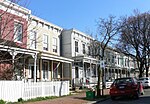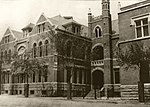Samuel Pleasants Parsons House
Buildings and structures completed in 1818Buildings and structures in Richmond, VirginiaFederal architecture in VirginiaGreek Revival architecture in VirginiaHistoric district contributing properties ... and 2 more
National Register of Historic Places in Richmond, VirginiaUnderground Railroad locations

The Samuel Pleasants Parsons House is a historic dwelling located at 601 Spring Street in Richmond, Virginia. It is best known for being the home of quaker, abolitionist, and prison superintendent Samuel Pleasants Parsons. It is likely that this house was once a stop on the Underground Railroad. It is the oldest remaining building within the Oregon Hill neighborhood.
Excerpt from the Wikipedia article Samuel Pleasants Parsons House (License: CC BY-SA 3.0, Authors, Images).Samuel Pleasants Parsons House
Spring Street, Richmond Oregon Hill
Geographical coordinates (GPS) Address Nearby Places Show on map
Geographical coordinates (GPS)
| Latitude | Longitude |
|---|---|
| N 37.539 ° | E -77.449777777778 ° |
Address
Spring Street 601
23220 Richmond, Oregon Hill
Virginia, United States
Open on Google Maps









